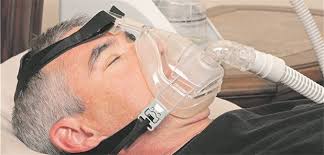
Bei Ihnen wurde Schlafapnoe diagnostiziert und eine CPAP Therapie verordnet. Zu Beginn der Behandlung stellen sich Fragen und Herausforderungen.
Erfahren Sie, was Sie über das Leben mit Schlafapnoe, die Bewältigung von Behandlungsherausforderungen und mehr wissen müssen.
Ein CPAP Gerät (Continuous Positive Airway Pressure) ist das am häufigsten verschriebene Gerät zur Behandlung von Schlafapnoe-Erkrankungen.
Was ist CPAP Therapie: Wie es funktioniert, Vorbereitung und Ergebnisse
Die CPAP Therapie ist eine wirksame Heimbehandlung für Menschen, die spontan atmen können, aber im Schlaf Schwierigkeiten beim Atmen haben.
CPAP hält die Atemwege eines Patienten kontinuierlich offen und stimuliert die Atmung durch das Pumpen von Luft mit einer Maschine.
So sieht eine CPAP Therapie aus
Bei der CPAP-Therapie handelt es sich um ein CPAP-Gerät, das Folgendes umfasst:
Eine Maske, die Nase und Mund bedeckt, eine Maske, die nur die Nase bedeckt, oder sogar Zinken, die in Ihre Nase passen.
Ein-Schlauch, der die Maske mit dem Motor des CPAP Geräts verbindet.
Ein-Motor, der Luft in das Rohr bläst.
Ein CPAP Gerät kann bestehen aus:
Ein Gerät zum Tragen im Gesicht wie
Vollgesichtsmaske, die das gesamte Gesicht bedeckt
Vollmaske, die Nase und Mund bedeckt
Nasenmaske, die die Nase bedeckt
Nasenkissen, das unter der Nase sitzt
Nasengabeln, die in die Nasenlöcher gehen
Ein Motor, der die Luft pumpt
Ein-Schlauch, der das Gerät mit der Maske verbindet
Ein Schlafarzt oder ein Pneumologe überwacht den Patienten normalerweise zuerst in einem Schlaflabor, um den optimalen Luftdruck für die Person zu bestimmen. Der Arzt hilft bei der Auswahl der richtigen Maske, die den Bedürfnissen des Einzelnen entspricht. Der Patient muss jede Nacht mit der Maske schlafen, während das CPAP-Gerät eingeschaltet ist.
Nebenwirkungen der CPAP Therapie
Einige der häufigsten Nebenwirkungen der CPAP Therapie sind die folgenden:
Das Gefühl der Klaustrophobie unter der CPAP Maske
Verstopfte Nase oder laufende Nase
Diese Nebenwirkungen können jedoch verhindert werden, wenn Sie überprüfen, ob Ihre Maske richtig angepasst ist. Die oben erwähnten nasalen Symptome können durch eine erwärmte Befeuchtung der CPAP Luft gelindert werden.
Die meisten CPAP Geräte sind mit einem beheizten Luftbefeuchter ausgestattet, also nutzen Sie diesen unbedingt.
Das Gefühl der Klaustrophobie unter der CPAP Maske
Verstopfte Nase oder laufende Nase
Diese Nebenwirkungen können jedoch verhindert werden, wenn Sie überprüfen, ob Ihre Maske richtig angepasst ist. Die oben erwähnten nasalen Symptome können durch eine erwärmte Befeuchtung der CPAP Luft gelindert werden. Die meisten CPAP Geräte sind mit einem beheizten Luftbefeuchter ausgestattet, also nutzen Sie diesen unbedingt.
Deutliche Abnahme der Tagesschläfrigkeit.
Wie effektiv ist die CPAP Therapie?
CPAP Therapie , CPAP hat sich als sehr wirksam erwiesen, um die Atemwege bei Menschen mit Schlafapnoe offen zu halten. Die Vorteile umfassen
Normale Schlafmuster
Verbesserte Schlafqualität
Bessere Konzentration und Gedächtnis
Wachsamkeit während des Tages
Beseitigung des Schnarchens
Senkung des Bluthochdrucks
Verbesserte allgemeine Gesundheit
Verbesserte Lebensqualität
